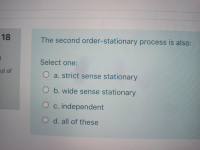
A First Course in Probability (10th Edition)
10th Edition
ISBN: 9780134753119
Author: Sheldon Ross
Publisher: PEARSON
expand_more
expand_more
format_list_bulleted
Concept explainers
Question

Transcribed Image Text:The second order-stationary process is alsc
Select one:
O a. strict sense stationary
O b. wide sense stationary
O c. independent
O d. all of these
Expert Solution
This question has been solved!
Explore an expertly crafted, step-by-step solution for a thorough understanding of key concepts.
Step by stepSolved in 2 steps

Knowledge Booster
Learn more about
Need a deep-dive on the concept behind this application? Look no further. Learn more about this topic, probability and related others by exploring similar questions and additional content below.Similar questions
- Q14arrow_forwardPt represents price at time t, and Qt represents shares outstanding at time t. Stock A splits three for one in the last period. Stock P0 Q0 P1 Q1 P2 Q2 A 115 600 120 600 40 1,800 B 100 600 95 600 95 600 C 75 700 80 700 80 700 Assuming that the divisor is equal to 3 at time 1, calculate the new divisor at time 2.arrow_forwardLet X B(25, 0.2). E(X?) = Select one: O a. 41 Оъ. 29 О с. 25 O d. 0arrow_forward
- Use the information below that has already been entered into MatLab using the ordered pairs (0.25, 0.5987), (0.5, 0.69150, (0.75, 0.7734), (1, 0.8413), and (1.25, 0.8944)to find the quartic interpolation. >> V=[1 .25 .25^2 .25^3 .25^4;1 .5 .5^2 .5^3 .5^4;1 .75 .75^2 .75^3 .75^4;1 1 1 1 1;1 1.25 1.25^2 1.25^3 1.25^4] V = 1.0000 0.2500 0.0625 0.0156 0.0039 1.0000 0.5000 0.2500 0.1250 0.0625 1.0000 0.7500 0.5625 0.4219 0.3164 1.0000 1.0000 1.0000 1.0000 1.0000 1.0000 1.2500 1.5625 1.9531 2.4414 >> Y=[.5987;.6915;.7734;.8413;.8944] Y = 0.5987 0.6915 0.7734 0.8413 0.8944 >> c=inv(V) *Y C = 0.5004 0.3947 0.0161 -0.0944 0.0245 g. How would you find A(0.92) where z=0.92 (DO NOT SOLVE!!!!)arrow_forwardCompute |A| for the following:arrow_forwardFind the solution to this recursive relation an = an−1 − n, a0 = 4arrow_forward
- Suppose that you have 8 green cards and 5 yellow cards. The cards are well shuffled. You randomly draw two cards with replacement. Round your answers to four decimal places. G1 = the first card drawn is greenG2 = the second card drawn is green a. P(G1 and G2) = b. P(At least 1 green) = c. P(G2|G1) = d. Are G1 and G2 independent?arrow_forwardFill in the table for the transition function for the FSA with the alphabet E = {0, 1} that recognizes the language of the regex (0*((1(01*0)*)1*)0*)* Please use the names of the states listed on the left as your answers in the table. 'zero' is the start state. state 1 zero one two The accept states are O A. zero O B. two O C. onearrow_forwardWhen looking at discrete-time signals and systems, the variable n can be said to: A. Possess units of amplitude B. Be unitless C. Have units of time D. Take any number value that this a real numberarrow_forward
- Classwork for Pre-AP ← → C D sd206.org bookmarks b Password Reset | bartle X M [EXTERNAL EMAIL] Loo X b Home | bartleby app.edulastic.com/student/assessment/6332ea3a4a6600000713dfcc/class/62f3b538951d49af6e3cfbda/uta/6335c837b51d6800090484b3/itemld/... G X E Edulastic: Formative an X E. Question 1/22 ← 10 1 The prices of the watches at a store are displayed in the box plot below. • SHOW HINT 16 Supreme Court Cas... e New Tab 30 $ 31 45 50 Find the interquartile range. > NEXT 70 Messenger 71 90 BOOKMARK ✓ CHECK ANSWER 110 120 130 X X + * 19 X ☐ ⠀ +arrow_forwardA parent downloads an app that allows him to monitor the amount of screen time his child is using on the phone. The child claims that she is only using 1 hour per day on the phone on average, but the app, over the course of 47 days, finds that the child used an average of 1.2 hours per day. The parent wants to know if the child is using an average of 1 hour per day for all days of use. a) The 1.2 is a/an: variable population parameter sample statistic observational unit b) The sample size is: 1 47 1.2 c) Each day is a/an: population parameter observational unit variable sample statisticarrow_forwardLet ü= Compute ü-ü. 3.arrow_forward
arrow_back_ios
SEE MORE QUESTIONS
arrow_forward_ios
Recommended textbooks for you
 A First Course in Probability (10th Edition)ProbabilityISBN:9780134753119Author:Sheldon RossPublisher:PEARSON
A First Course in Probability (10th Edition)ProbabilityISBN:9780134753119Author:Sheldon RossPublisher:PEARSON

A First Course in Probability (10th Edition)
Probability
ISBN:9780134753119
Author:Sheldon Ross
Publisher:PEARSON
